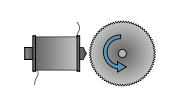
Tonewheel
Encyclopedia

Note
In music, the term note has two primary meanings:#A sign used in musical notation to represent the relative duration and pitch of a sound;#A pitched sound itself....
s. The tonewheel assembly consists of a synchronous AC motor
Electric motor
An electric motor converts electrical energy into mechanical energy.Most electric motors operate through the interaction of magnetic fields and current-carrying conductors to generate force...
and an associated gearbox
Transmission (mechanics)
A machine consists of a power source and a power transmission system, which provides controlled application of the power. Merriam-Webster defines transmission as: an assembly of parts including the speed-changing gears and the propeller shaft by which the power is transmitted from an engine to a...
that drives a series of rotating disks. Each disk has a given number of smooth bumps at the rim; these generate a specific frequency as the disk rotates close to a pickup assembly that consists of a magnet
Magnet
A magnet is a material or object that produces a magnetic field. This magnetic field is invisible but is responsible for the most notable property of a magnet: a force that pulls on other ferromagnetic materials, such as iron, and attracts or repels other magnets.A permanent magnet is an object...
and coil
Coil
A coil is a series of loops. A coiled coil is a structure in which the coil itself is in turn also looping.-Electromagnetic coils:An electromagnetic coil is formed when a conductor is wound around a core or form to create an inductor or electromagnet...
.This is electrically and magnetically similar to a guitar pickup, in that a permanent magnet is placed within the coil and the moving element is unmagnetized. Unlike most generators or dynamos, there is no external field applied through the moving part. The frequency depends on the speed of rotation of the disk and the number of bumps. A single fundamental frequency
Fundamental frequency
The fundamental frequency, often referred to simply as the fundamental and abbreviated f0, is defined as the lowest frequency of a periodic waveform. In terms of a superposition of sinusoids The fundamental frequency, often referred to simply as the fundamental and abbreviated f0, is defined as the...
can be combined with one or more harmonics to produce complex sounds. A tonewheel was used in the Telharmonium
Telharmonium
The Telharmonium was an early electronic musical instrument, developed by Thaddeus Cahill in 1897. The electrical signal from the Telharmonium was transmitted over wires; it was heard on the receiving end by means of 'horn' speakers.Like the later Hammond organ, the Telharmonium used tonewheels to...
and in the original Hammond organ
Hammond organ
The Hammond organ is an electric organ invented by Laurens Hammond in 1934 and manufactured by the Hammond Organ Company. While the Hammond organ was originally sold to churches as a lower-cost alternative to the wind-driven pipe organ, in the 1960s and 1970s it became a standard keyboard...
s.
Tonewheel leakage occurs in the Hammond organ and in similar situations, where the large number of tonewheels causes pickups to overhear tonewheels other than their own. This causes the organ to add chromatics
Chromatic scale
The chromatic scale is a musical scale with twelve pitches, each a semitone apart. On a modern piano or other equal-tempered instrument, all the half steps are the same size...
to played notes. In some kinds of music this is undesirable, but in others it has become an important part of the Hammond sound. On some digital simulations of Hammond organ
Hammond organ
The Hammond organ is an electric organ invented by Laurens Hammond in 1934 and manufactured by the Hammond Organ Company. While the Hammond organ was originally sold to churches as a lower-cost alternative to the wind-driven pipe organ, in the 1960s and 1970s it became a standard keyboard...
s tonewheel leakage is a user-set parameter.

